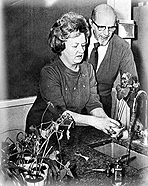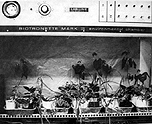About Positive Music
By Don Robertson (1997, slightly revised 2005 and 2022)
Este artículo en español aquí The Effects of Music
Music has a definite effect on people, animals, and plants. In fact, it has a powerful influence on our body, mind, and emotions. Music with a ‘beat’ can stimulate your body; music with powerful melodies and harmonies performed with feeling can make you weep or cry out with joy; and music like the fugues of Bach and Mozart can be mentally invigorating. Every Hollywood movie producer is aware of the power of music, and that is why it plays such a key role in motion pictures. The music that accompanies movies grabs our feelings.
Often when I talk about a particular kind of music having a particular kind of effect, I am told: “But that simply cannot be true. Music affects people in different ways, or the same person differently at different times.” Music may seem to affect people differently, but that is because people can react differently to the music. We can apply a personal process to the music that we hear. If someone hates jazz, then a jazz piece with a positive effect will probably not make him feel good.
What we are talking about here is a filter. A filter is something that changes something that is passed through it by allowing only a certain part to pass through. We all have our built-in filters, our likes and dislikes. These can block the direct effect that music might have. A happy song may appear to make an angry person angrier, yet it is not the music itself that is creating the anger; rather it is the positive effect of the music. The angry person does not want to accept the song’s happy feeling: it points out his already existing anger, and causes that anger to come to the surface.
The Science of Sound
Please bear with me as I get a bit technical. I would like to discuss the effects of music in a scientific matter, to get to the root of the subject.
Music is a vibratory phenomenon. Air particles are set in motion and these air particles in turn set matter that is within hearing distance into motion. This is called vibrational sympathy: When the vibrations of sound effect the airwaves, the airwaves effect other matter that they come into contact with in a manner that is in sympathy with the originating source. An example of vibrational sympathy is the sympathetic strings on the North Indian musical instrument called the sitar. The sitar is a large wooden instrument that has strings attached to it not unlike a guitar. These are the strings that are played by the musician when he or she is performing. Underneath these main strings, however, is a full set of strings that are tuned to the scale of the composition that is being played. The performer never plays these sympathetic strings except occasionally, simply for effect. The purpose of the sitar’s sympathetic strings is to give the sitar a richer sound. When a note is plucked on one of the main strings of the instrument, the sympathetic strings vibrate in sympathy with the main note. The sound that is produced by one of the main strings, when it is plucked, vibrates the airwaves and causes the secondary sympathetic string to vibrate, in sympathy. Thus, for every note played on a string on the instrument, two strings sound.
The effect of vibrational sympathy is easy to demonstrate. A well-known example is the cliché story about the opera singer who sings a note so high and so perfect that it shatters a crystal goblet. You can demonstrate the principal of vibrational sympathy for yourself. Open the lid of a piano and while someone holds down the right pedal – the one that releases the dampers on the strings – shout into the sound chamber of the piano. All the strings that are tuned in a pitch that resonates with the tones in your voice will begin vibrating in sympathy and will produce a rush of sound.
Music Scales
When music is played, the vibrations of the music affect all life in the vicinity. The effect that the music has will depend upon the way that the vibrations of the music are harmonically constructed. One of the factors that determines the effect of music is the musical scale from which the melody and harmonies are built. Different scales create different modes and emotions. The scales on which music is based are not an arbitrary creation of man; they are formed on very definite patterns that are the intrinsic to all nature.
During the late 1700’s, scientists began identifying certain chemical elements for the first time. In 1808, a scientist named John Dalton suggested that the atoms that make up matter were physical objects that had specific weights. In 1829, Johann Doebereinger demonstrated that elements could be arranged in groups of three, according to their weights. In each group of three, the elements had similar properties, and the weight of the middle atom in the group was close to the average of the other two. These were said to be chemical equivalents to the musical triad, the basic chord in music. In 1864, a man named John A. Newlands grouped all the known elements in the order of their atomic weights. He then divided these into groups of seven elements each. He demonstrated that when the atoms were put into order with their weights increasing, there was a pattern of repetition that was identical to the musical octave, the same found on the piano keyboard. When he talked to his fellow chemists of the time about this “law of octaves,” they laughed at him.
In 1869, Dmitri Mendeleev compiled a Periodic Table of the Elements. This table was arranged according to atomic weights and was based on Newlands’ work. Mendeleev found, as had Newlands, that the chemical properties of the elements recurred at definite intervals. He likewise concluded that these were the periodic functions of their atomic weights. According to Daniel Morris, in his article “Music of the New Spheres” in the December 1969 Chemistry Magazine, Mendeleev’s arrangement of the elements came to him while he was listening to a performance of Robert Schumann’s “Piano Quintet, Opus 44” (a wonderful piece of music, by the way). He was seated on a sofa, apparently mulling over Newland’s and Doebereinger’s arrangements of the elements, when suddenly, he jumped up, sat at his desk, and arranged all the elements in a more complete and final way than had Newlands. In his article, Morris wondered if the music of the quintet hadn’t influenced Mendeleev’s arrangement of the elements in the periodic table.
Mendeleev’s chart of the elements now hangs in every high-school chemistry lab as a testimony to the endurance of his work. Comparing this chart and the musical octave, we can see the interrelationship that occurs between nature, in its material essence, and nature as sound and music.
The basic chord of music is called the triad. It provides the basic underpinnings of the seven-note scale: the scale of the octave. A triad can be demonstrated by playing a simple C major chord containing three notes: C, E, and G. The triad that Johann Doebereinger found in the relationships of atomic structures was based on a principal that he found to be like the principal of a musical triad. The musical triad also corresponds to the three primary colors of the color spectrum that can be seen when light is passed through a prism. These colors are red, yellow, and blue: the only three colors that cannot be created by combining other colors. Yes, there is a color octave also. The same patterns that are the basis of sound and music are also the basis of all nature. No wonder music has such a “sympathetic” effect.
The Positive and Negative in Music
When a major triad chord is played, and you are listening to it, your body, mind, and feelings resonate with the three notes of the chord. Because it is the basic chord of harmony, it is harmonious. Matter resonates harmoniously and positively. In 1968, I discovered that there was a chord that was opposite to this chord. While the triad is positive, this chord, which I call the duochord, is negative. It consists of four notes (based on C, they would be: C, Db, F# and G). Its effects are negative. Music that is based on this chord invokes a negative sympathetic reaction.
The musicians of ancient cultures like China, India, Turkey and Greece understood these principals. In ancient Greece, Pythagoras introduced a whole science concerning them. Because the musicians of these ancient cultures understood these principals, they created music that was positive, uplifting, and beneficial.
Once the effects of music are better understood, the next step is gaining a better understanding of the music around us, and the effect that it is having.
The Plant Experiments
In 1973, a woman named Dorothy Retallack published a small book called The Sound of Music and Plants. Her book detailed experiments that she had been conducting at the Colorado Woman’s College in Denver using the school’s three Biotronic Control Chambers. Mrs. Retallack placed plants in each chamber along with speakers through which she played sounds and particular styles of music. She watched the plants and recorded their progress daily. She was astounded at what she discovered.
Her first experiment was to simply play a constant tone. In the first of the three chambers, she played a steady tone continuously for eight hours. In the second, she played the tone for three hours intermittently, and in the third chamber, she played no tone at all. The plants in the first chamber, with the constant tone, died within fourteen days. The plants in the second chamber grew abundantly and were extremely healthy, even more so than the plants in the third chamber. This was a very interesting outcome, very similar to the results that were obtained from experiments performed by the Muzak Corporation in the early 1940s to determine the effect of “background music” on factory workers. When music was played continuously, the workers were more fatigued and less productive, when played for several hours only, several times a day, the workers were more productive, and more alert and attentive than when no music was played.

with the plants used in music experiments.
Further Experiments
For her next experiment, Mrs. Retallack used two chambers (and fresh plants). She placed radios in each chamber. In one chamber, the radio was tuned to a local rock station, and in the other the radio played a station that featured soothing “middle-of-the-road” music. Only three hours of music was played in each chamber. On the fifth day, she began noticing drastic changes. In the chamber with the soothing music, the plants were growing healthily, and their stems were starting to bend towards the radio! In the rock chamber, half the plants had small leaves and had grown gangly, while the others were stunted. After two weeks, the plants in the soothing-music chamber were uniform in size, lush and green, and were leaning between 15 and 20 degrees toward the radio. The plants in the rock chamber had grown extremely tall and were drooping, the blooms had faded, and the stems were bending away from the radio. On the sixteenth day, all but a few plants in the rock chamber were in the last stages of dying. In the other chamber, the plants were alive, beautiful, and growing abundantly.
Mrs. Retallack’s next experiment was to create a tape of rock music by Jimi Hendrix, Vanilla Fudge, and Led Zeppelin. Again, the plants turned away from the music. Thinking maybe it was the percussion in the rock music that was causing the plants to lean away from the speakers, she performed an experiment playing a song that was performed on steel drums. The plants in this experiment leaned just slightly away from the speaker; however not as extremely as did the plants in the rock chambers. When she performed the experiment again, this time with the same song played by strings, the plants bent towards the speaker.

Next, Mrs. Retallack tried another experiment, again using the three chambers. In one chamber she played North Indian classical music performed by sitar and tabla, in another she played Bach organ music, and in the third, no music was played. The plants “liked” the North Indian classical music the best. In both the Bach and sitar chambers, the plants leaned toward the speakers, but the plants in the Indian music chamber leaned toward the speakers the most.
She went on to experiment with other types of music. The plants showed no reaction at all to country and western music, similarly to those in silent chambers. However, the plants “liked” the jazz that she played them. She tried an experiment using rock in one chamber, and “modern” (discordant) classical music of negative composers Arnold Schönberg and Anton Webern in another. The plants in the rock chamber leaned 30 to 70 degrees away from the speakers and the plants in the modern classical chamber leaned 10 to 15 degrees away.
I spoke with Mrs. Retallack about her experiments a few years after her book was published, and at that time I began performing my own experiments with plants using a wood-frame and clear-plastic-covered structure that I had built in my back yard. For one month, I played three-hours-a-day of music from Arnold Schönberg’s negative opera Moses and Aaron, and for another month I played three-hours-a-day of the positive music of Palestrina. The effects were clear. The plants subjected to Schönberg died. The plants that listened to Palestrina flourished.
In these experiments, albeit basic and not fully scientific, we have the genesis of a theory of positive and negative music. What is it that causes the plants to thrive or die, to grow bending toward a source of sound or away from it?
Negative Music
We probably wouldn’t use the term positive music at all except for the fact that negative music has become such an issue. Traditionally, in most societies, people have played only positive music.
Then what is negative music?
It is music that stimulates the negative emotions such as anger, frustration, depression, hatred and fear.
The Viennese classical composer Arnold Schönberg, whom I mentioned above, was the first person to openly create negative music early in the twentieth century. His music was rejected by European concert attendees of the time and sometimes caused near riots. Based on discords, Schönberg’s music caused listeners to feel uncomfortable and irritated. However, Schönberg became the pivotal composer of the early twentieth century and today he is considered one of the greatest composers of that century. Schönberg’s music ushered in an era of negative music in Western (European) classical music that lasted for over fifty years. His theory of twelve-tone music, where all notes assumed an equal identity and the principles of harmony on which the world’s music were based were rejected, was accepted by composers throughout the Western world and was taught in the finest music schools.
The result of all this was the incorporation of negative music into TV programs and movies. Negative music is used to create emotions of suspense, terror, anxiety, and fear. It is the music that accompanies crime programs and horror films. The same kind of music that concert audiences rejected because of the feelings that the music invoked became standard TV fare, and for the very same reasons.
Arnold Schönberg opened the door to negative music: music that employed discordant intervals and harmonies. Many composers during the twentieth century followed in his footsteps and produced a body of music that was either fully negative or incorporated negative elements into the music that they wrote. Any person who is aware of how music affects them, will feel the effects that negative classical music has upon them when they listen to it.
Western classical music was the first style of music to incorporate negativity. The next step in the “evolution” of negative music was its introduction into rock music in the late 1960s. The first hard rock and heavy metal music was produced by the rock group called Blue Cheer in 1967. Their music was angry and had a noticeably heavy beat. Shortly after this, a group called MC-5 came out with a recording of early “hard-rock” music. At this time, the music of the Rolling Stones became harder and angrier, with a negative accent. Many other groups sprang up during this period. In truth, hard drugs, mixed with psychedelics were having an effect. The world was witnessing a new phenomenon: musical groups of young people were using electrified instruments to bring in a new music that was harmful to the human psyche, destructive, and angry.
The last three decades of the twentieth century saw negative rock music spread and popularized throughout the entire world. Heavy metal music became an accepted culture, and from it other forms of negative music, such as punk and grunge, emerged.
Positive Music
Positive music can be found in all cultures and all times. The world has a treasure trove of great positive music. With the advent of advanced sound-reproduction technologies such as the CD and the internet, this treasure trove is only now being discovered. For example, during the last decade of the 20th century, many people in Europe and America discovered for the first time a music that they had never heard before: Gregorian chant. In fact, a recording of Gregorian chant reached pop music status in England, much the same as Pachabel’s “Canon in D” had done during the 1970s. What did people find so enjoyable about such music? Gregorian chant, if you will, was “church music”…. medieval church music at that! What people liked about Gregorian chant was the calm, serene state of mind, and the warm feeling that the music induced in them.
I personally know about the power of chant. During the 1970s, I used recordings of Gregorian chant in my work counseling people with problems, and I found that the music could have miraculous effects. I once played a recording of my favorite Gregorian chants for a lady musician friend, and she immediately broke into tears of love and joy before me.[1]
If you listen to the radio carefully and use your powers of discernment to gain a sense of the degree of negativity in the music that you hear on the radio and TV today, you will find a great deal of the music that is lacking in positive influence. Pop music has gone downhill so much since its heyday in 1954 that the difference is shocking. In 1954, the songs of the top forty were positive, reinforcing, romantic. Singers sang with their heart, and people felt their songs. There are some wonderful, great singers, today—thank God for that—but there is also a lot of inferior, mediocre singers, and music that expresses little in the lyrics and nothing emotionally—except perhaps anger and hatred. And so many people have gotten used to mediocrity and ugliness in music that it isn’t even noticed anymore. And rap music? It is the final blow to song: It is “the Grinch who stole Melody.”
Rock music has become a vehicle for negative music. However, when I talk about rock music being negative, I want to make it clear that I am not talking about all rock music. A person who develops their sense of discernment will be able to tell the difference. In 1969, I discovered the rock band called the Moody Blues. I fell in love with the Moody Blues and listen to their music to this day. Their first seven albums were the crème of their work and far surpass all they have done since. The Moody Blues are the positive rock band’s positive rock band. In my opinion, no other group can match the Moody Blues in the ability to infuse rock music with positive feelings and content.
[1] It was Constance Demby (1939-2021)
The Moody Blues
The first time that I saw the Moody Blues in concert was at the Denver Coliseum in 1970. At that time, their records were the only records that I was listening to, and I was extremely anxious to see them. I remember well the band that opened the show for them. It was a negative band. From their act and the sound of their music, I guessed that they were probably all loaded on heroin and speed. They were grinding out guitar discords while the lead singer angrily shouted out the songs, and the drummer beat on his snare and cymbals.

The concert had been sold out and there was a near-riot occurring in front of the coliseum because so many people had to be turned back. Not wanting to listen to the opening band, I decided to walk around and survey the situation. The air was filled with tension and apprehension. Tempers were short. People were uptight.
The tension continued to mount and finally, the opening band was finished. They left the stage, and on came the Moody Blues. The Moody Blues stepped up to their microphones, and as they launched into their opening number, “Gypsy”, the auditorium was suddenly filled with blue light. It was awesome. The Moody Blues held everyone spellbound for two hours. The music was lofty and spiritually uplifting. When the concert was over, I noticed that people were relaxed, smiling, and beaming.
I was handing out flyers for my new book Kosmon to the people who were leaving the building. The next day, a fellow called me, as our phone number was on the flyer. He told us that he had a transformative spiritual experience during the concert. His whole being had been transformed, he said, filled with light, and he had witnessed the presence of angels around him. He wanted to know if I could explain this to him.
I had had an experience like that myself in the San Francisco Opera House, of all places. The second act of Wagner’s Tristan and Isolde took me to heights well beyond normal reality: a realm of light and beauty, and I could see and sense the presence of angels all around me. These kinds of experiences are life-transforming and are never forgotten. Individuals who haven’t realized the existence of God and the spiritual world will scoff at words such as these, but nevertheless, this is the truth. And this is the ultimate testimony of music: a great agent of transformation for today’s society-in-need.
